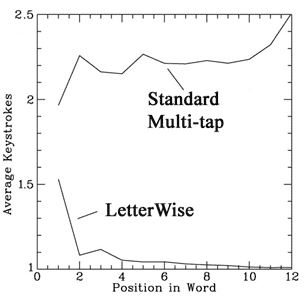LetterWise |
|
|
|
|
|
No reason to believe us about it, see what users say, and try the demo yourself to find out why over 20 million devices worldwide feature LetterWise. Then see what the press says, and who our customers are.
If you are a usability or telecommunications professional, review our research.
To discuss commercial terms, or for other inquiries please visit our Contact Page.
Eatoni's LetterWise Predictive Text System
LetterWise is the simplest possible text entry system. It is even simpler than multi-tap. The users manual is one sentence, "hit the key with the letter you want, if it doesn't come up, hit Next until it does." More than 1/2 of all users who have T9 do not use it, since it is too difficult. This leaves them with multi-tap, which most people find too laborious. LetterWise is needed to increase the use of text messaging and email, especially among demographics such as the old (older than 25) who find multi-tap too painful and T9 too unreliable and complicated, and the young (younger than 13) who can not spell (a requirement for successful use of T9) and even the coveted 13-25 group, who can spell, but choose not to, who can use T9, but choose not to.
LetterWise is available in 165 languages, three times more languages than T9.
T9 is useless for names and addresses, since these are typically not found in the T9 dictionary. LetterWise has no dictionary: you can write anything you want. This is essential for any application based on search, such as e-commerce applications. Most products (think e.g. of recording artists) have names not found in the T9 dictionary and yet these can be easily entered from the keypad using LetterWise, and thus searched for, and bought.
Comparison: the word 'sirs'
Standard Multi-Tap Method:
Tap '7' four times for 's'
Tap '4' three times for 'i'
Tap '7' three times for 'r' (+ advance)
Tap '7' four times for 's'
Total keystrokes: 15
LetterWise Method:
Tap '7' once for 's'
Tap '4' once, then Next for 'i'
Tap '7' once for 'r'
Tap '7' once for 's'
Total keystrokes: 5
Comparison: The Quick Brown Fox
As an example, consider the classic sentence "The quick brown fox jumped over the lazy dog" for testing typing ability. The number of keystrokes required to enter each letter is shown below the letter, for standard multi-tap and LetterWise. In standard multi-tap, the example sentence (35 letters) requires 42 extra taps, while LetterWise requires only 14 more.
| the | quick | brown | |
| Multi-tap | 122 | 22332 | 23312 |
| LetterWise | 111 | 41111 | 31111 |
| fox | jumps | over | |
| Multi-tap | 332 | 12114 | 3323 |
| LetterWise | 111 | 31211 | 1211 |
| the | lazy | dog | |
| Multi-tap | 122 | 3142 | 131 |
| LetterWise | 111 | 1141 | 212 |
The quick brown fox is much quicker with LetterWise.
After the first letter it's almost like using a typewriter
This graph shows the expected number of keystrokes as a function of the position in the word for standard multi-tap and LetterWise. It is seen that the number of keystrokes is high for standard multi-tap, and remains high until the end of the word. For LetterWise, however, the number of keystrokes becomes close to one per letter after the first letter of a word is entered. Even for the first letter of a word, LetterWise requires far fewer keystrokes than standard multi-tap.
Scalable memory requirement
LetterWise summarizes the statistics of a language in a very small database. It then stores the data optimally and scalably. That is, given any number of bytes available on a storage medium such as a SIM card, a linguistic database can be automatically generated to best take advantage of the available storage space. The more storage space available, the better the results. However, excellent results are obtained with only a few kilobytes of storage. For example just a 3kb database offers great performance for most alphabetic languages. In general, the memory required to store a database for a typical word-guessing algorithm for just one language is enough to store data for about 30 languages using LetterWise.
Summary
LetterWise is extremely user friendly, fast and accurate, and requires little memory. It can dramatically expand the utility of any handheld device.
| Page tools: Content [Comments] [Printable version] |





